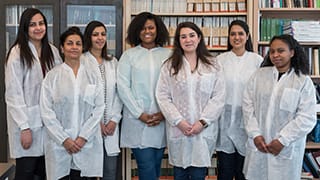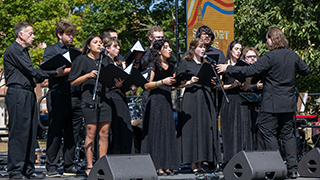Cutting Edge Science – Literally
Wednesday, February 22nd, 2017

With their most recent work published in a number of prestigious biochemistry journals,
Professor Raj and her team of student researchers focus on developing new biochemical
methodologies for the rapid sequencing, or "mapping," of proteins and their building
blocks, peptides.
In sequencing or "mapping" these peptides and proteins – in a sense the building blocks
of life – scientists can better see, identify, diagnose and fix malfunctions that
can lead to disease.
To that end, the Raj research group works at synthesizing peptides and proteins to ultimately block disease states — including cancer, Parkinson's and age-related maladies such as Alzheimer's.
Professor Raj was named Seton Hall Faculty Researcher of the Year in 2016. Notably, her article, "Site-Selective Chemical Cleavage of Peptide Bonds," authored along with Ph.D. student Hader Elashal and published in The Royal Society of Chemistry's Chemical Communications, was named "F1000 Prime recommended," which means that a global Faculty of the world's leading scientists and clinicians selected and honored this research as "important" work.
Chemical Cleavage

Much like a mother separating two unwieldy children, as the study of disease and its
cures advances, modern molecular and medical research has put much of its emphasis
on separating these proteins behaving badly. Unlike parenthood, however, the ultimate
goal in medical research is to isolate the instigator and kill it.
But to kill a bad acting protein, one must know it—and that's where the work of Professor Raj and her students comes in. They have found a way to chemically cleave or break the offending proteins apart in a way that gives researchers a clear view of the transgressor, allowing them to sequence, or "map," the diseased or mutated proteins. Previous cutting methods, although good for healthy proteins, were not compatible with the cutting of these diseased or mutated ones.
The cutting or cleavage process developed by Professor Raj's team allows researchers to clearly see and map the constituent parts of malfunctioning proteins as well as, importantly, isolating them. This allows researchers the ability to devise remedies— including synthesizing unique peptides and proteins to essentially eliminate the diseased or mutated ones— that are specific for these affected molecules without adversely affecting other healthy molecules in near proximity.
Revolutionizing Protein Synthesis: Faster, Better, More

The Raj group has revolutionized protein synthesis. In laboratories all across the
world, scientists synthesize peptides and then group these peptides together to formulate
proteins. At present, it is a cumbersome and tedious process, with many steps burdened
by the necessary addition of many extraneous substances; it is largely governed by
the limitations of the current state of lab machinery which allows for the combination
of only 50 amino acids at a time to create peptides. Proteins often contain 100,000
amino acids. The process can take days.
Through their discovery of a totally chemical process for synthesizing protein, Professor Raj and her team of students have cut that time down to hours, excised many of the input substances from the process (thus extremely limiting a number of extraneous byproducts in the results) and increased the yield of protein by double-digit multiples. In short, they have found a way to synthesize proteins chemically in significantly less time with greater purity and a far greater yield: Faster, better, more.

The revolutionary research on protein synthesis, published for 2017 as an Advance Article in The Royal Society of Chemistry's high-impact journal, Chemical Science, is entitled "Serine promoted synthesis of peptide thioester-precursor on solid support for native chemical ligation." Professor Raj authored the work along with graduate students Hader Elashal and Yonnette Sim.
Additional research and publications from the Raj Group for 2016
Organic Letters, "Glutamic Acid Selective Chemical Cleavage of Peptide Bonds," authored by Professor Raj along with Ph.D. student Neelam Lahankar and undergraduate students Lyssa Buiserreth and Joseph Nalbone '16.
Chemical Communications, "Fmoc solid-phase synthesis of C-terminal modified peptides by formation of a backbone cyclic urethane moiety" authored by Professor Raj along with Ph.D. students Hader Elashal and Ryan Cohen.






